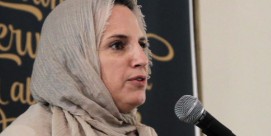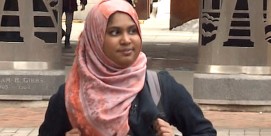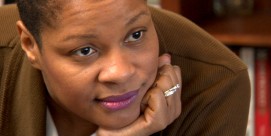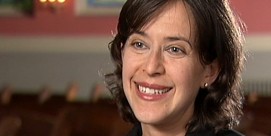BOB ABERNETHY: Now, the secular world and sacred art. Deborah Rosenthal is a respected artist who is also an observant Jew. How does she put those worlds together -- the secular New York art scene and ancient sacred themes? Joseph Dorman has our report.
JOSEPH DORMAN: Deborah Rosenthal is an unusual figure in today's art world: a modern artist whose work is infused with her religious beliefs. Recently, she was asked by the conservative Jewish congregation to which she belongs to create two stained glass windows for its sanctuary. For the commission, she chose two objects drawn from Jewish faith and Jewish history, the first a pomegranate.
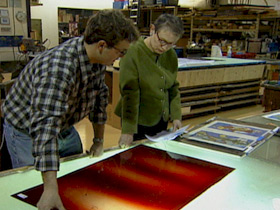
DEBORAH ROSENTHAL (Artist): The theme really comes from the ancient temple in Jerusalem. The one object that is claimed to remain from the temple that you can see in the Israel Museum is a microscopic stylized ivory pomegranate. Since a synagogue is the latter-day replacement for the temple, I thought of connecting the space to the temple through the pomegranate.
DORMAN: For the second window, she chose a tree representing the Jewish Holy Book, the Torah, which is considered the Tree of Life. Like her stained-glass windows, Rosenthal's paintings often focus on biblical or religious themes. Her work draws from her own imagination as well as the world around her, mixing figures and abstract forms in dream-like compositions rich with symbolic meaning.
Ms. ROSENTHAL: The metaphoric process is the key link, really, between the way I am religious as a Jew and myself as a painter. The bible is full of metaphors. All of the ways we express our description of God, for instance, in Judaism are understood to be metaphors, since we believe in a god that has no physical or material presence. I think the particular kind of truth I'm after does have something to do with dreams, myths, a kind of level of reality that isn't in the here and now.
DORMAN: Deborah Rosenthal was born into a family of conservative Jews who celebrated Sabbath and the Jewish holidays. From a young age, she felt the pull of her own deep religious impulse. As she grew up, she found herself becoming increasingly observant and by the time she was getting her MFA degree, she was keeping kosher and moving in the direction of Orthodox Judaism.
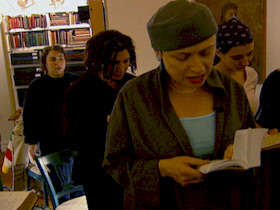
Ms. ROSENTHAL: I grew up along with two brothers in a home that was profoundly Jewish-identified. I went to Hebrew school. I was originally at college in a setting where there were relatively few Jews at Smith and I felt strongly impelled to be very Jewishly involved.
DORMAN: At the same time that Rosenthal was deepening her involvement in orthodox Judaism, she was feeling excluded from its many restrictions on women. During the holiday of Simchas Torah, which celebrates God's gift of the Torah to the Jews, she and a number of friends decided to lead their own service. It proved to be a profound experience, which led to the creation of a women's-only prayer group.
Ms. ROSENTHAL: The idea was for women literally to carry and hold the Torah during the Simchas Torah festivities and it grew into women's reading the Torah for other women and it was a different experience for all of us who had never been called up to the Torah, who had never stood there with the Torah scroll and read it. I believe you can be radical; you can go to the root of a tradition and if the tradition is a moral one, which I believe Judaism is, it recognizes your presence on the earth.
DORMAN: Much of Rosenthal's work reflects her love of medieval Christian religious art. The use of biblical imagery in these paintings and stained glass windows, along with their brilliant use of pattern and color to reflect an inner spiritual world, have clearly provided inspiration for her own paintings.
Ms. ROSENTHAL: I think that I'm operating as a modern artist out of similar impulses to the religious impulses of earlier artists, whether Islamic artists in 10th-century Egypt or medieval western artists in France in the 12th century or 11th century looking at things that are internal things that one feels, things that one knows, and attempting to give them pictorial structure.
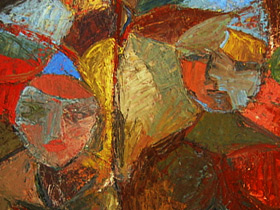
MARK STEVENS (Art Critic): One of the things that I like about Deborah's art is that she uses painting itself and the traditions of painting to arrive at her ends; she bumps up forms against one another and uses colors in such a way to create a light that seems to escape materiality or suggest some other dimension to life. She's not just spiritually driven; she's first of all, a painter.
DORMAN: Several years ago, Rosenthal began re-imagining the role of the Jewish woman in a series of paintings about the Bible's first woman, Eve. She turned for inspiration to a sculpture of Eve by a 12th-century religious artist named Gislebertus. In Rosenthal's works such as "Eve, The Mother of All Living Things," and "Eve, The Life of the Flower," Eve is the first mother and the sole inhabitant of an abstract Eden of flowers and human faces.
Ms. ROSENTHAL: The image of Eve at Autun is a figure who appears alone, she's an Eve without an Adam, which was intriguing to me -- the notion of the mother giving birth to the world. It's one of the most powerful and one of the most familiar great images of Eve in Western art, and when I saw it in the flesh and I drew from it, it seemed like a figure who suggested a way of building a kind of metaphor about a creative, what someone calls, an alpha female.
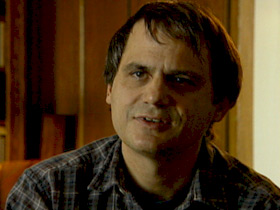
Mr. STEVENS: Deborah is a contemporary painter in part because she doesn't enclose herself within one tradition. She has an open eye to other traditions and other times as well. That's typical of our moment. Any spiritually serious painter who's questioning is going to look, not just at his or her own tradition, but at other traditions. And if they're generous, if they're really an individual seeker, they're going to make themselves available to other influences.
DORMAN: As Rosenthal creates the stained glass windows for her congregation, she is acutely aware that she is linked to these many traditions of religious art. She also knows that she's come late to those traditions. In the past, art was created in a world steeped in religion and in the idea of the sacred. Today, working in a secular age, her task is infinitely more difficult.
Ms. ROSENTHAL: I don't think it's possible to create sacred art at this point. Sacred art is the collective expression of a society, even among the religious, there isn't an audience that readily understands all of the signs and all of the motifs and I think what I'm doing is working out of my own beliefs, out of my own obsessions, some of which have to do with religious thoughts, religious impulses, but I know that I have to speak to you as the viewer, whether you are moved by a religious impulse yourself or not.
For RELIGION & ETHICS NEWSWEEKLY, I'm Joseph Dorman.





